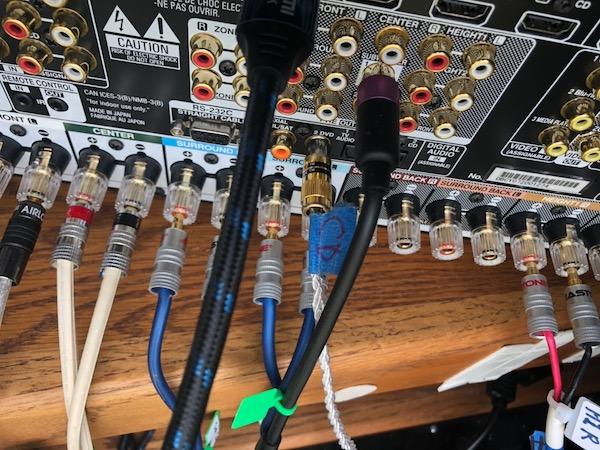Making the Connection

Can cables sound different?
In my experience yes, but the differences are typically subtle no matter how much you spend. It's also easy to fool yourself into thinking you're hearing significant differences. I've never tried a $37,000 pair of speaker cables in a familiar system, nor do I expect or even have any desire to. But the price and appearance of a product, whether we're talking about audio, cars, or anything else, can exert a powerful tug on our perceptions. I've often thought that if you put a Krell, Boulder, or any other premium-priced amplifier into a budget-chassis with unassuming cosmetics it might be a hard sell to a buyer shopping for a high-end amp. Ditto for loudspeakers; the most premium speaker drivers and top-grade crossover network, in a sturdy but plain jane, vinyl trimmed cabinet, would likely gather dust on the showroom floor.
But I digress to make a point. You should pay more attention to a cable's durability for its purpose, plus the optimum gauge of the wire, than its appearance. In addition, if you want to drop big bucks on cables (and by big bucks here I mean low hundreds of dollars and not thousand!) assign premium cables only to the three front loudspeakers. And unless the distance from those speakers to their amps is more than 20 feet or so, 16-gauge cables (or even 18 gauge), consisting of reasonably good, pure copper wire (not copper clad aluminumavoid that!) with decent connectors (again, not fancy or outrageously expensive) should be fine. For surrounds and Atmos channels with longer runs, 12- or even 16-gauge copper should be more than enough for most installations.
The flexibility of the cables you choose is also an important consideration, particularly for those lengthy runs. There's a school of thought among some expensive cable makers that solid wire, rather than stranded, is sonically superior. We could argue the point, which is dubious at best, but wire consisting of multiple thin strands is invariably more flexible and easier to deal with than solid copper.
You can often save significant money if you make your own loudspeaker cables, but only if you're reasonably adept at the DIY game. But even if you're unsure as to which end of a soldering iron to grab, it's possible to fabricate speaker cables with no soldering required. All you need are the cables and good connectors. I prefer banana plugs, most of which have one two small screws that secure the stripped end of the cable to the plug. Just be sure to tighten these screws securely and be sure there are no straggling, bare wire ends that might induce a short. And use caution; it's easy for the small screwdriver needed to secure the wire to the connector to slip out of the screw slot and stab your finger! (Ask me how I know...)
For RCA interconnects most of you will be better off buying ready-made. Again, you shouldn't have to take out a bank loan to afford them. Just be sure that they're a snug but not impossibly tight fit for your equipment. That shouldn't be an issue, but it can be. A plug and jack combination should always fit well and function properly, but isn't always ideal. RCA Jacks and plugs are made to well-defined standards, but not to 00.00. It's still possible to get a too-loose or too-tight combination. A slightly loose fit, while not ideal, will nearly always work, but a too tight plug-to jack connection can be an issue. I've had the experience (more than once) of a very tight RCA plug actually pulling off part of the jack when trying to unplug it! The missing piece could usually be re-inserted, but if a connection feels unusually tight don't force it. If you buy your ready-made RCA cables from Amazon (they offer a bewildering variety), or any other reputable seller, they should be willing to exchange them if they're too tight for the jacks on your AVR or other gear.
You can create DIY balanced cables as well, but why? Most of you won't need them. For a typical audio or home theater system balanced audio cables simply aren't needed in the distances involved. Balanced cables are useful mainly in professional setups where distances measured in meters are common and long runs of unbalanced cables could result in noise pickup. Balanced connectors do have a reassuringly snug (but not too snug! ) plug-to-jack fit, but offer no sonic advantages (though some might disagree). Balanced jacks are typically not found on AVRs but are often used on A/V preamp-processors and some high-end two-channel gear.
As for other types of cables often used in A/V settings, such as USB or HDMI, DIY isn't possible. But I've rarely had an issue with such connections. If you're running a long cable to a projector, however, I recommend a fiber-optic HDMI connection. This can be a tad pricey, but it avoids the fun of running a long HDMI cable to the projector, with all of the contortions that usually entails, only to find that the conventional HDMI cable you chose is too long and doesn't work reliably. Just be careful in handling a fiber-optic cable. They aren't overly delicate, but bend them at too sharp an angle and you might have to replace them. They can't be "repaired."

























































